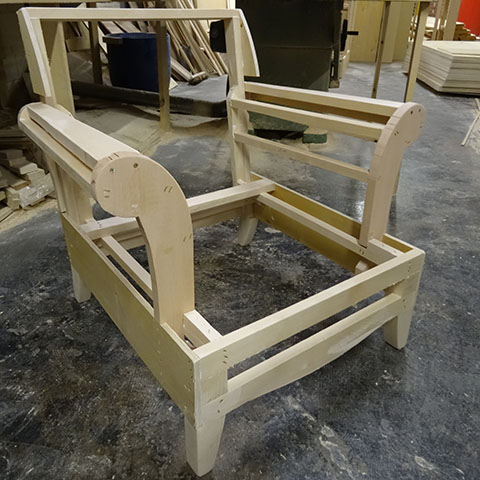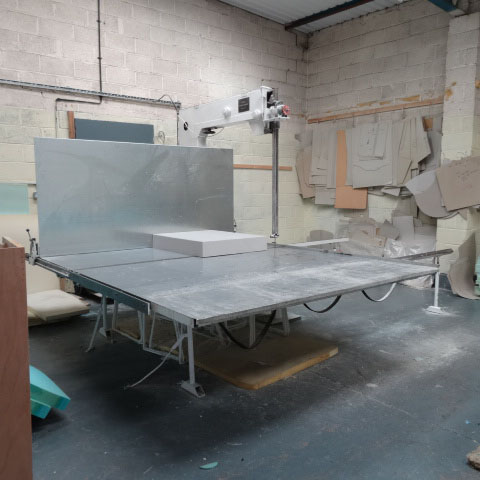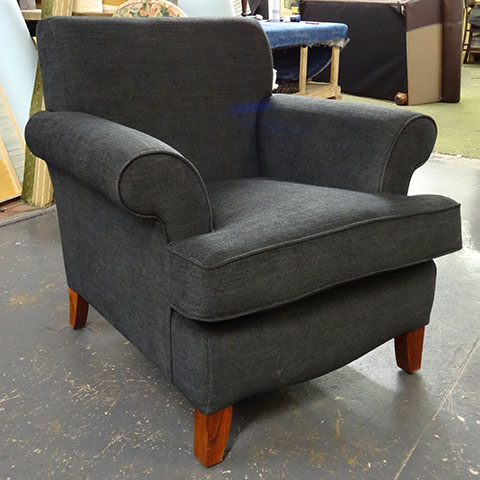


Here at Regis Upholstery we can produce a piece of furniture from the ground up. From making the frame to your design to covering it in the fabric, colour and stitching you require.
Our highly skilled team can produce high quality, bespoke items to compliment any surrounding, be it domestic or commercial, from your newly decorated 'man-cave' to the most modern office. Below is a brief insight to some of the techniques we as a company employ to craft each and every stool, chair or sofa than comes off our production line.
Take a look at our furniture section, we think you'll be impressed.

First the frame is constructed from wood that has been found clear of any defects. The thickness of the wood should allow for the heavy tension webbing to follow. If the frame is not sufficiently strong, it will not bear the weight redistributed into it by the webbing whenever someone sits down.
Arms, back, or back sections, seat, and legs are attached. The preferred method is with clean-cut, fitted double doweled glue joints reinforced with comer braces, glued and also screwed into place.
Each major part of the sofa will have to have springs attached separately, and also be padded separately. Consequently, they are "framed out" with reinforcing slats, arranged around the seat section.
The foundation is then set for padding. Jute, a kind of burlap made in India, is used as webbing. Strips of this material are interwoven, stretched across the frame, and tacked down. Flax twine is then used to strap the springs onto the webbing. Two lines of twine are tacked into position and then tied around a spring back to front.
If heavy-gauge springs are used in the "front row," these are further tied down with a length of wire. This process is repeated for the back, with special attention to the springs at the base, which are treated like the front row of seat springs. If the back comes in sections, then each part is separately tied off and the twine ends tacked onto the four-sided frame. The same is true for any sides and arms.

Each part is separately padded, with layers of burlap and horsehair or chosen synthetic material. The padding is placed in a burlap envelope, pinned into place, and stitched down. Each part is separately padded as well, with layers of burlap and horsehair or chosen synthetic material. The padding is placed in a burlap envelope, arranged on the edge of the seat, pinned into place, and stitched down. This roll is then shaped according to design requirements and stitched with special needles and more twine.
The layer is basted into place with long, loose stitches and covered with lighter weight burlap. Tighter stitching divides the seat into two areas called the platform and the nose or front edge. This front part is reshaped with hand stitching. After the shaping is completed, a final, thicker layer of padding is added to fill in dips left by stitching in the burlap, and basted like the previous layer. A muslin sheet of covering is applied, stitched into the break between the platform and nose, tightened across the front edge and back across the platform; its edges are tacked into place.
The arms are done next in the same basic fashion. Layers of padding and burlap are fixed in succession and topped with muslin. The arms also have a front edge of extra thick padding. Once the arms are properly shaped the back or back sections may be padded. If there is more than one part to the back, the center is padded first up until the second burlap layer.
Then, the two flanking sections are padded up to that point, to match the center in size. The edge roll is formed around the top and back of the crest rail or uppermost part of the frame, or the corresponding area of each of the back parts, each of which must be kept parallel to the others.


Every piece and panel that will be fabric covered must be measured and recorded in a cutting list. The fabric is purchased in one piece or lot. The panels are then plotted out in chalk so they match wherever their seams will meet when finally applied. If any of the panels and pieces need to be sewn together before being attached to the padded frame, this is taken care of first.
The seat is covered with panels for the platform and nose and hand-stitched into place along the break between them over a layer of cotton batting. The nose is then covered first to check if the pattern continues along the front properly. The covering is fitted over the back or platform end and secured. The arms are covered next after being prepped with their own layers of cotton batting. A series of strategically placed cuts may be made, so the fabric clears all obstructions presented by the frame. Temporary tacks are replaced one by one with permanent tacks.
The outside is the last part to be padded and covered, starting at the arms. The open area is covered with a layer of burlap, an outside cotton padding, and finally the finishing fabric. Covering is fabric-stitched on top and tacked into place on the bottom, front, and back. The largest panel left open is the outside back.
If the webbing has left any gaps between frame slats, these must be stuffed. Padding should be basted over the gaps along the whole outside back. The fabric panel for this section may be welted, or edged with a decorative strip made of stuffing cord covered in matching fabric.